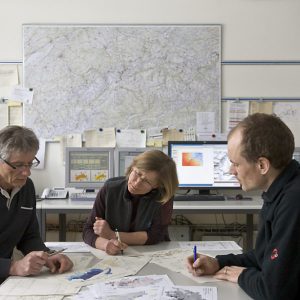Find, as you go, the articles in our series on the 2021 Regional District, by clicking here.
The health crisis and the necessary “distancing” in the education system have highlighted the inequality of equipment among pupils. It was cruel, in fact, to notice the gap between, on the one hand, those who could connect and take courses remotely, and on the other hand, those who only had at best a computer to share with the whole family, or who did so. their homework on their smartphone and they ended up dropping out.
“We saw in the spring of 2020 that a certain number of students had their phones or tablets just to pursue distance learning. This equipment is not suitable. Then we bought and loaned 6000 computers to those who need them”, recalls Bertrand Deneut, vice president of the Normandy Regional Council in charge of secondary schools and education.
This experience convinced the Normandy community to act. From the beginning of the 2021 school year, it will publish a “High School Digital Package”. Principle: Lend a laptop to any general, technology, or professional second-year student or first-year CAP student entering a public, private, or rural (MFR) family home, or 40,000 students for the month of September. All at an estimated cost of 20 million euros.
In principle, the initiative satisfies almost everyone. But as soon as we talk about practical details, doubt arises, especially among teachers.
“From experience, we know that equipment intended for educational use without consultation with those concerned, without taking into account the demands and needs of teachers in their subject can quickly turn to waste”Pointe Claire Jevel, National Secretary of the Snes-FSU, and Professor of History and Geography at Haute-Normandy.
Some disciplines, notably the career path, may require the use of software that is completely greedy for storage space, for example, a computer must be able to support it. However, the history and geography teacher, who is also a member of her high school board of directors, had never heard of such discussions.
Equipment is not always equal
However, it is not necessary to go far to find examples of boondoggles. In Ile-de-France, for example, the computers awarded by the district at the start of the 2020 school year did not always meet the needs of high school students.
“The facilities were well received as they have proven to be essential to a large number of families. But there are still a number of technical issues to be resolved. Because of the protections put in place so that pupils cannot access certain content, it is impossible to install new software”, details Jesselyn Morvan Dubois, President of FCPE Paris.
In addition, computers do not have enough memory, and the hardware is very fragile. Families who already had better quality computers eventually left them. “
In the early days of the Ile-de-France experiment, some parents and teachers viewed computer lending as a powerful shift to digital textbooks. However, Norman families and teachers are not particularly interested in this.
“A paper booklet is a very reliable thing, we can rely on when digital technology is not working. Computers for high school students should not be used at the expense of the district’s participation in the purchase of paper textbooks”Claire Gevil warns.
Unlike the department, the district is not obligated to fund or loan textbooks to students. However, a significant part of the regional authorities are involved. So far, Normandy has allocated an aid of 70 euros for the purchase of textbooks for students of general and technological roads or 40 euros for the professional path.
This technique is not used
Normandy, Occitanie, Ile-de-France, Grand Est … Whatever the region, the implementation of loan or donation systems for computers over the past three years seems like a fad. But the wardrobe now looks a bit Ancient.
We especially remember President François Hollande’s “tablet plan” in 2015: a 1 billion euro digital plan planned over three years, thanks to which, for every euro the department board invests in individual mobile equipment for one student, the state paid 1 euro. Seven years later, many of these monitors sleep in college lockers.
The Audit Bureau also expressed its regret for this measure in light of the large resources allocated to it. “It has hurt the realization of investments in the infrastructure and networks necessary to connect institutions and schools, without which educational uses of digital technology cannot be created.”And the Then the wise men wrote.
Doesn’t Norman’s plan also risk obscuring the need to renew enterprise IT equipment that is often outdated or defective? Or liberate the region from its obligations in this area? The latter would like to be reassured: the community will also invest 6 million euros in the modernization of digital infrastructure and the deployment of wifi stations in public secondary schools.
But we can still go back to the early 2000s to find traces of similar devices.
“Fifteen years ago, local authorities distributed digital bags and microcomputers in such-and-such classroom, first in Landes and then in Bouches-du-Rhône, Ille-et-Vilaine and others. This obviously changed nothing in terms of the evolution of teaching practices. at the school level, contacts Pascal Plantard, Professor of Education at Rennes-2 University, an anthropologist with digital uses.
In addition, computers had problems with maintenance, departmental services had great difficulty maintaining them and support was completely inadequate. “
“What assessment can be drawn from it? Very significant financial investments but not necessarily the expected success. We also know that increased use of digital tools does not always go hand in hand with better academic outcomes. Lots of research has been published, but policy makers tend to ignore or ignore it.” “Adds Cedric Flückiger, associate professor of educational sciences and computer science education in Lille.
Because in addition to equipment inequalities, the use of digital technology is already in question.
The fundamental problem is that the dominant representations of digital technology are technology-centric representations, including representations on the political side. Most strategies rely on deceptive perceptions that are sufficient to provide a technical solution to answer an educational and social problem., defines Pascal Plantard.
The Normandy region has planned to set up training to support young people in their use of digital technology. It remains to design his content, plan the speakers and … budget for him. Which has not happened to this day.

“Certified gamer. Problem solver. Internet enthusiast. Twitter scholar. Infuriatingly humble alcohol geek. Tv guru.”





